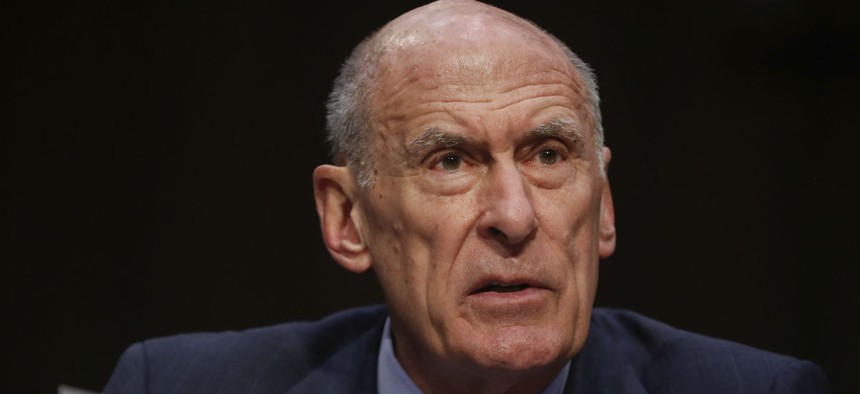
Director of National Intelligence Dan Coats testifies before the Senate Armed Services Committee in March. Pablo Martinez Monsivais/AP
National Intel Office Restructures to Improve Operations
The ODNI stood up four new directorates to better develop the workforce and integrate intelligence, and improve decision-making.
Seeking “agility” in operations and analysis, the Office of the Director of National Intelligence on Wednesday unveiled the fruits of the transformation effort it announced in March, standing up four new directorates reporting to deputy directors.
The new directorates support integrating intelligence; enabling national security partnerships; driving resources and capability decisions; and aligning the IC’s current focus with future strategy.
“Our comprehensive approach to transformation covered many areas, including synchronizing and streamlining processes, better developing our people, improving the efficiency and effectiveness of our decisions, and aligning our structure to support those outcomes,” Director of National Intelligence Dan Coats said in a statement on Wednesday.
“The goal of the transformation is to shape an ODNI that the founders envisioned, that the Intelligence Community needs, and that the moment demands,” added Principal Deputy Sue Gordon.
The purpose, the agency noted, is to posture ODNI to be able to attract the best workforce, manage data securely, improve acquisition and technology, partner effectively with the private sector, and develop “a comprehensive posture for cyber.”
With altered priorities under a new mission and vision statement, the ODNI transformation “also allows for better integration of the ODNI’s mission-focused centers to provide whole-of-IC insight on key issues like cybersecurity, terrorism, and insider threats to ensure a coordinated approach in partnership with the new directorates, and to be key players in the ODNI’s new governance structure and development of our workforce,” it added.
The restructuring came in two phases, according to assistant director of national intelligence for acquisition, technology and facilities Kevin Meiners, who spoke in April to a gathering of the industry group Intelligence and National Security Alliance. The first focused on sore spots and inefficiencies, and the second on mission and vision, he said: “In the first phase, “you’re still doing your same job . . . by the time you get to [the second phase], you should be able to look around and say, ‘I think I can do my job better.’”
Meiners’ deputy, Kelly Gaffney, said that too often in the past, decisions at ODNI were not always well documented or explained, and lacked follow-through. “So the goal here is to have a more strategic decision-making process and to push some of that decision-making down . . . lower in the organization.”
Also this week, ODNI teamed up with the Pentagon to win a policy dispute over whether to release more of the national security agency’s classified “black budget.” Some senators in debating the fiscal 2019 National Defense Authorization Act had proposed moving some secret money in the Air Force budget, for example, to the general defense budget to discourage what are called “pass-through” spending items.
As reported by Federation of American Scientists secrecy blogger Steven Aftergood, Coats expressed his objections in a letter co-signed by Pentagon Comptroller David Norquist, and the proposal was removed from the NDAA during this week’s conference.
In February, as required by law, the ODNI released its overall budget request for fiscal 2019: $59.9 billion, up from $57.7 billion appropriated in fiscal 2018.
NEXT STORY: The Meaning of North Korea’s Remains Transfer







